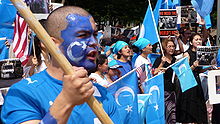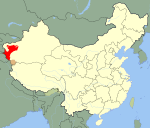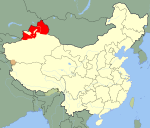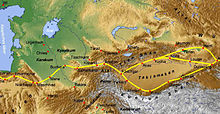- East Turkestan
-
East Turkestan Chinese name Traditional Chinese 東突厥斯坦 Simplified Chinese 东突厥斯坦 Transcriptions Mandarin - Hanyu Pinyin Dōng Tūjuésītăn Alternative Chinese name Traditional Chinese 東土耳其斯坦 Simplified Chinese 东土耳其斯坦 Transcriptions Mandarin - Hanyu Pinyin Dōng Tǔěrqísītǎn Uyghur name Uyghur شەرقىي تۈركىستان
Sherqiy TürkistanEast Turkestan (also East Turkistan, Eastern Turkestan, and other variants) is a controversial political term with multiple meanings depending on context and usage. Historically, the term was invented by Russian Turkologists in the 19th century to replace the term Chinese Turkestan, which referred to the Tarim Basin in the southwestern part of Xinjiang province of the Qing Dynasty. The medieval Arab toponym "Turkestan" and its derivatives were not used by the local population of the greater region, and China had its own name for an overlapping area since the Han Dynasty as Xiyu, with the parts controlled by China termed Xinjiang from the 18th century onward. The historical Uyghur name is Qurighar (西域; today, Qurighar Uyghur is co-used with Shinjang Uyghur by Uyghurs).
Starting in the 20th century, Uyghur separatists and their supporters used East Turkestan (or "Uyghurstan") as an appellation for the whole of Xinjiang, or for a future independent state in present-day Xinjiang Uyghur Autonomous Region. They reject the name of Xinjiang because of an allegedly Chinese perspective reflected in the name, and prefer East Turkestan to emphasize connection to other westerly Turkic groups. However, even in nationalist writing, East Turkestan retained its older, more narrow geographical meaning. In China, the term has negative connotations because of its origins in European colonialism and present use by militant groups. The government of China actively discourages its use.
Contents
Current usage
 The term "East Turkestan" is primarily used by, and is associated with, Uyghur separatists (diasporic protest in Washington, D.C. shown)
The term "East Turkestan" is primarily used by, and is associated with, Uyghur separatists (diasporic protest in Washington, D.C. shown)
The term "East Turkestan" is inextricably linked with politics.[1] In general, most of the toponyms for places in Central Asia—although its boundaries and Xinjiang's inclusion in it are disputed—do not reflect the region's diversity.[2] As the history of Xinjiang in particular is contested between the government of China and Uyghur separatists, the official and common name of Xinjiang [Uyghur Autonomous Region] (with its Uyghur loanword counterpart, Shinjang) is rejected by those seeking independence.[1] "East Turkestan", a term of Russian origin, asserts a continuity with a "West Turkestan", or the now-independent states of Soviet Central Asia.[3] Not all of those states accept the designation of "Turkestan", however; Tajikistan's Persian-speaking population feels more closely aligned with Iran and Afghanistan.[2] For separatists,[4][5] East Turkestan is coterminous with Xinjiang, or the independent state that they would like to lead in Xinjiang.[6] Proponents of the term "East Turkestan" argue that the name Xinjiang (Chinese: 新疆; pinyin: Xīnjiāng; Postal map spelling: Sinkiang) is arrogant, because if the individual Chinese characters are to be taken literally and not as a proper name, then Xinjiang means "New Territory".[7] The official translation for "Xinjiang" is "old territory returned to the motherland".[8] Some Chinese scholars have advocated a name change for the region, or a reversion to the older term Xiyu, arguing that "Xinjiang" might mislead people into thinking that Xinjiang is "new" to China. Other scholars defend the name, noting that Xinjiang was new to the late Qing Dynasty, which gave Xinjiang its current name.[7]
In modern separatist usage,[1] "Uyghurstan", which means "land of the Uyghurs", is a synonym for Xinjiang or a potential state in Xinjiang,[9] like "East Turkestan".[10][11] There is no consensus among separatists about whether to use "East Turkestan" or "Uyghurstan";[12] "East Turkestan" has the advantage of also being the name of two historic political entities in the region, while Uyghurstan appeals to modern ideas of ethnic self-determination. Uyghurstan is also a difference in emphasis in that it excludes more peoples in Xinjiang than just the Han,[13] but the "East Turkestan" movement[14] is still a Uyghur phenomenon. Kazakhs and Hui Muslims are largely alienated from the movement,[9] as are Uyghurs who live closer to the eastern provinces of China. Separatist sentiment is strongest among the Uyghur diaspora,[1] who practice what has been called "cyber-separatism", encouraging the use of "East Turkestan" on their websites and literature.[15] Historically "Uyghurstan" referred to the northeastern oasis region of "Kumul-Turfan".[16] "Chinese Turkestan", while synonymous with East Turkestan in historical terms,[17] is not used today, rejected by Uyghur separatists for the "Chinese" part of the name and by China for the "Turkestan" part.[18]
In China, the terms "East Turkestan", "Uyghurstan",[13] and even "Turkestan" alone connotes old Western imperialism and the past East Turkestan republics, and modern militant groups, such as the East Turkestan Islamic Movement (ETIM). The government of China conflates the violence of differing separatist groups, such as the ETIM and the East Turkestan Liberation Organization, as coming simply from "East Turkestan forces".[18] Chinese diplomatic missions have objected to foreigners' use of "East Turkestan". They argue that the term is political and no longer geographical or historical, and that its use represents "a provocation" to the sovereignty of China.[7] The historical definitions for "East Turkestan" are multivarious and ambiguous, reflecting that outside of Chinese administration,[12] the area now called "Xinjiang" was not geographically or demographically a single region.[1]
History of the term
Early terminology
In China, the term Western Regions (Chinese: 西域; pinyin: Xīyù; Uyghur: Qurighar) referred to the regions west of the Yumen Pass, and more specifically the Tarim Basin in Xinjiang that had come under the Han Dynasty's control since 60 BC. Since the Han, successive Chinese governments had to deal with secessionist movements and local rebellions from different peoples in the region.[19] However, even when Xinjiang was not under Chinese political control, Xinjiang has long had "close contacts with China" that distinguish it from the independent Turkic countries of Central Asia.[18] The Gökturks, known in Chinese as the Tujue (Chinese: 突厥; pinyin: Tūjué) united the Turkic peoples and created a large empire, which broke into various Khanates; the West Tujue Khanate inherited Xinjiang, but West Tujue became part of China's Tang Dynasty until the 9th century. However, the terms for West Tujue and East Tujue do not have any relation with the terms West and East Turkestan.[19] "Turkestan", which means "region of the Turks", was defined by Arab geographers in the ninth and tenth centuries as the areas northeast of the Sir River.[7] For those Arab writers, the Turks were Turkic-speaking nomads, and not the sedentary Persian-speaking oasis dwellers.[18] With the various migrations and political upheavals following the collapse of the Gökturk confederation and the Mongol invasions "Turkestan" gradually ceased to be a useful geographic descriptor, and was not used.[20]
During the sixteenth century, the Chagatai Khanate completed the Islamification and Turkification of western Xinjiang and the surrounding region, known then as Moghulistan, while China's Ming Dynasty held the Eastern Areas. After the Fall of the Ming Dynasty, a western Mongol group established a polity in "Chinese Tartary" as it was sometimes known, or in eastern Xinjiang, expanding southward into southern Xinjiang.[12] In 1755, the Qing Dynasty defeated the Mongol Dzungar Khanate and captured two territories in Xinjiang. The northern territory, where the Dzungars lived, was called Dzungaria, while the southern areas which the Dzungars controlled and mined were called Huijiang (Chinese: 回疆; pinyin: Huíjiāng; "Muslim territory") or Altishahr.[18] The term "Xinjiang", which up until that time simply meant all territories new to the Qing, gradually shifted in meaning for the Qing court to exclusively mean Dzungaria and Altishahr taken together. In 1764, the Qianlong Emperor made this use of Xinjiang as a proper name official, and issued an imperial order defining Xinjiang as a "provincial administrative area". After General Tso suppressed the Dungan revolt in 1882, Xinjiang was officially reorganized into a province and the name Xinjiang was popularized,[7] superseding "Xiyu" in writing.[1]
At the same time as the Chinese consolidation of control in Xinjiang, explorers from the British and Russian empires explored, mapped, and delineated Central Asia in a competition of colonial expansion. Several influential Russians would propose new terms for the territories, as in 1805 when the Russian explorer Timovski revived the use of "Turkestan" to refer to Middle Asia, and "East Turkestan" to refer to the Tarim Basin east of Middle Asia in southern Xinjiang; or in 1829, when the Russian sinologist Nikita Bichurin proposed the use of "East Turkestan" to replace "Chinese Turkestan" for the Chinese territory east of Bukhara.[3] The Russian Empire mused expansion into Xinjiang,[21] which it informally called "Little Bukhara". Between 1851 and 1881, Russia occupied the Ili valley in Xinjiang, and continued to negotiate with the Qing for trading and settlement rights for Russians.[22] Regardless of the new Russian appellations, the original inhabitants of Central Asia generally continued not to use the word "Turkestan" to refer to their own territories.[23]
After a spate of annexations in Middle Asia, Russia consolidated its holdings west of the Pamir Mountains as the Turkestan Governate or "Russian Turkestan" in 1867.[24] It is at this time that Western writers began to divide Turkestan into a Russian and a Chinese part.[20] Although foreigners acknowledged that Xinjiang was a Chinese polity, and that there were Chinese names for the region, some travelers preferred to use "names that emphasized Turkic, Islamic, or Central Asian, i.e., non-Chinese characteristics".[12] For contemporary British travelers and English-language material, there was no consensus on a designation for Xinjiang, with "Chinese Turkestan", "East Turkestan", "Chinese Central Asia", "Serindia"[25] and "Sinkiang" being used interchangeably to describe the region of Xinjiang.[3] Until the 20th century, locals used the names of cities or oases in their "territorial self-perception", that expanded or contracted as needed, such as Kashgaria out of Kashgar to refer to southwestern Xinjiang. "Altishahr", or "six cities", collectively referred to six vaguely defined cities south of the Tian Shan.[12]
Early 20th century
In 1912, a Republican Revolution overthrew the Qing Dynasty and created a Republic of China. As Yuan Dahua, the last Qing governor, fled from Xinjiang, one of his subordinates, Yang Zengxin (杨增新), took control of the province and acceded in name to the Republic of China in March of the same year. In 1921, the Soviet Union officially defined the Uyghurs as the sedentary Turkic peoples from Chinese Turkestan as part of their nation building policy in Central Asia.[3] Multiple insurgencies arose against Yang's successor Jin Shuren (金树仁) in the early 1930s throughout Xinjiang, usually led by Chinese Muslims.[26] "East Turkestan" became a rallying cry for people who spoke Turki and believed in Islam to rebel against Chinese authorities.[20] In the Kashgar region on November 12, 1933, Uyghur separatists declared the short-lived[14] and self-proclaimed East Turkestan Republic (ETR), using the term "East Turkestan" to emphasize the state's break from China and new anti-China orientation.[23]
The First ETR gave political meaning to the erstwhile geographical term of East Turkestan.[18] However, the Chinese warlord Sheng Shicai (盛世才) quickly defeated the ETR and ruled Xinjiang for the decade after 1934 with close support from the Soviet Union.[27] Eventually, though, the Soviet Union exploited the change in power from Sheng to Kuomintang officials to create the puppet Second East Turkestan Republic (1944–1949) in present-day Ili Kazakh Autonomous Prefecture to exploit its minerals,[28] later justifying it as a national liberation movement against the "reactionary" Kuomintang regime.[3] Amid the anti-Han programs and policies[27] and exclusion of "pagans",[20] or non-Muslims, from the separatist government,[28] Kuomintang leaders based in Dihua (Ürümqi) appealed to the long Chinese history in the region to justify its sovereignty over Xinjiang. In response, Soviet historians produced revisionist histories to help the ETR justify its own claims to sovereignty, with statements such as that the Uyghurs were the "most ancient Turkic people" that had contributed to world civilization.[3] Traditionally, scholars had thought of Xinjiang as a "cultural backwater" compared to the other Central Asian states during the Islamic Golden Age.[12] Local British and American consuls, also intrigued by the separatist government, published their own histories of the region. The Soviet Uyghur histories produced during its support of the ETR remain the basis of Uyghur nationalist publications today.[3]
Late 20th century
At the end of the Chinese Civil War in 1949, with Xinjiang divided between Kuomintang forces and ETR secessionists, the Communist leadership persuaded both governments to surrender and accept the succession of the People's Republic of China government,[27] and negotiated the establishment of Communist provincial governments in Yining (Ghulja) and Dihua.[29] On October 1, 1955, PRC leader Mao Zedong designated Xinjiang a "Uyghur Autonomous Region",[1] creating a regionwide Uyghur identity which overtook Uyghurs' traditionally local and oasis-based identities.[30] Although the Soviet Union initially suppressed the publications of its past Uyghur studies programs, after the Sino-Soviet split in the 1960s, it revived its Uyghur studies program as part of an "ideological war" against China.[3][11] The term "East Turkestan" was popularized in academic works,[19] but inconsistently: at times, the term East Turkestan only referred to area in Xinjiang south of the Tian Shan mountains, corresponding to the Tarim Basin;[19] the areas north of the Tian Shan mountains were called Dzungaria or Zungaria.[31][17][7] Tursun Rakhimov, a Uyghur historian for the Communist Party of the Soviet Union during the Sino-Soviet split,[32] argued in his 1981 book "Fate of the Non-Han Peoples of the PRC" that "both" East Turkestan and Dzungaria were conquered by China and "renamed" Xinjiang. Occasionally, he used East Turkestan and Xinjiang interchangeably.[3] Concurrently during the Cultural Revolution and the Revolution's campaigns against "local nationalism", the government had come to associate the term East Turkestan with Uyghur separatism and "foreign hostile forces" and forbade its usage.[7] The global trends set by the Dissolution of the Soviet Union in the 1990s, and the rise of global Islamism[1] and pan-Turkism[33][34] revived separatist sentiments in Xinjiang and led to a wave of political violence that killed 162 people between 1990 and 2001.[19] In 2001, the government of China lifted its ban on state media's using the terms "Uyghurstan"[1] or "East Turkestan",[35] as part of a general opening up after the September 11 attacks to the world about political violence in Xinjiang and a plea for international help to suppress what they see as "East Turkestan terrorists".[19][9]
References
- ^ a b c d e f g h i Starr, S. Frederick (2004). Xinjiang: China's Muslim Borderland. M.E. Sharpe. pp. 6–7, 11, 14.
- ^ a b Humphrey, Caroline; Sneath, David (1999). The End of Nomadism? Society, State, and the Environment in Inner Asia. Duke University Press. pp. v-vi.
- ^ a b c d e f g h i Bellér-Hann, Ildikó (2007). Situating the Uyghurs between China and Central Asia. Ashgate Publishing. pp. 4–5, 32–40.
- ^ Sheridan, Michael (2008-07-27). "Islamist bombers target Olympics". London: The Sunday Times. http://www.timesonline.co.uk/tol/sport/olympics/article4406836.ece. Retrieved 2011-02-05. "The group may be allied with the East Turkestan Islamic Movement – designated a terrorist organisation by the US, China and several other countries – which seeks independence for the Muslim Uighur people of China's far west province of Xinjiang, which Uighur separatists call East Turkestan."
- ^ Chung, Chien-peng (July/August 2002). China's "War on Terror": September 11 and Uighur Separatism. Foreign Affairs. http://www.foreignaffairs.com/articles/58030/chien-peng-chung/chinas-war-on-terror-september-11-and-uighur-separatism. "Beijing now labels as terrorists those who are fighting for an independent state in the northwestern province of Xinjiang, which the separatists call "Eastern Turkestan.""
- ^ Wong, Edward (2010-07-09). "Chinese Separatists Tied to Norway Bomb Plot". The New York Times (Beijing). http://www.nytimes.com/2010/07/10/world/asia/10uighur.html. Retrieved 2011-02-05. "Many Uighurs call Xinjiang their homeland, and some want an independent state there called East Turkestan."
- ^ a b c d e f g Rahman, Anwar (2005). Sinicization Beyond the Great Wall: China's Xinjiang Uighur Autonomous Region. Troubador Publishing Ltd. pp. 20–26.
- ^ "History and Development of Xinjiang". Government of the People's Republic of China. May 2003. http://www.gov.cn/english/official/2005-07/28/content_17948.htm. Retrieved 2011-02-05.
- ^ a b c Van Wie Davis, Elizabeth (January 2008). "Uyghur Muslim Ethnic Separatism in Xinjiang, China". Asia-Pacific Center for Security Studies. http://www.apcss.org/Publications/APCSS--%20Uyghur%20Muslim%20Separatism%20in%20Xinjiang.doc. "The desired outcome by groups that use violence is, broadly speaking, a separate Uyghur state, called either Uyghuristan or Eastern Turkistan, which lays claim to a large part of China.... The largest [Muslim] group, the Hui who have blended fairly well into Chinese society, regard some Uyghurs as unpatriotic separatists who give other Chinese Muslims a bad name.... China's official statement on "East Turkestan terrorists" published in January 2002 listed several groups allegedly responsible for violence"
- ^ Bovingdon, Gardner (2005). Autonomy in Xinjiang: Han nationalist imperatives and Uyghur discontent. Political Studies 15. Washington: East-West Center. pp. 17. ISBN 1932728201. http://www.eastwestcenter.org/fileadmin/stored/pdfs/PS011.pdf
- ^ a b Shulsky, Abram N. (2000). Deterrence Theory and Chinese Behavior. RAND Corporation. p. 13.
- ^ a b c d e f Bellér-Hann, Ildikó (2008). "Place and People". Community Matters in Xinjiang, 1880-1949: Towards a Historical Anthropology of the Uyghur. Brill. pp. 35–38, 44–45.
- ^ a b Priniotakis, Manolis (2001-10-26). "China's Secret Separatists: Uyghuristan's Ever-Lengthening Path to Independence". The American Prospect. http://www.prospect.org/cs/articles?article=chinas_secret_separatists. Retrieved 2011-02-05.
- ^ a b Pan, Guang (2006). "East Turkestan Terrorism and the Terrorist Arc: China's Post-9/11 Anti-Terror Strategy". China and Eurasia Forum Quarterly (Central Asia-Caucasus Institute and Silk Road Studies Program) 4 (2): 19–24. http://www.silkroadstudies.org/new/docs/CEF/Quarterly/May_2006/Guang.pdf.
- ^ Moneyhon, Matthew D. (October 2003). "Taming China's 'Wild West': Ethnic Conflict in Xinjiang". Peace, Conflict, and Development (5): 9, 17. http://www.peacestudiesjournal.org.uk/dl/TamingChina%27sWildWest.PDF.
- ^ Gladney, Dru C. "The Ethnogenesis of the Uighur". Central Asian Survey 9 (1).
- ^ a b Herbertson, Fanny Dorothea (1903). Asia. Adam & Charles Black. p. xxxv. "Sin-tsiang is made up of the Tarim basin or Chinese (Eastern) Turkestan and Zungaria. The former is a desert with marginal oases where rivers descend from the mountains. The chief centres are Yarkand and Kashgar. Zungaria is a relatively low and fertile steppe land, leading from the low-lands of Southern Siberia to the Mongolian plateau."
- ^ a b c d e f Millward, James A. (2007). Eurasian Crossroads:A History of Xinjiang. Columbia University Press. pp. ix-x, 95.
- ^ a b c d e f M.E. Sharpe; Trenin, Dmitrii and Huasheng Zhao (2007). Central Asia: Views from Washington, Moscow, and Beijing. pp. 141–143.
- ^ a b c d "Origin of the "East Turkistan" Issue". State Council of the People's Republic of China. 2003-05-01. http://www.china.org.cn/e-white/20030526/4.htm. Retrieved 2011-02-05.
- ^ Tayler, Jeffrey (2008). Murderers in Mausoleums: Riding the Back Roads of Empire Between Moscow and Beijing. Houghton Mifflin Harcourt. p. 244. "Russia, whether or not it had designs on India, was expanding throughout Central Asia and saw no reason that Xinjiang should not belong to the tsar as did other Central Asian lands to the west."
- ^ Rahul, Ram (1997). Central Asia: An Outline History. Concept Publishing Company. p. 88.
- ^ a b Central Asian Review (London: University of Virginia) 13 (1): 5. 1965.
- ^ Bregel, Yuri (1996). Notes on the Study of Central Asia. Research Institute for Inner Asian Studies. "Strictly speaking, 'Russian Turkestan' as a political term was limited only to the territory of the governorate-general of Turkestan and did not include... the khanates of Bukhara and Khiva"
- ^ Meyer, Karl Ernest; Brysac, Shareen Blair (2006). Tournament of Shadows: The Great Game and the Race for Empire in Central Asia. Basic Books. p. 347. "Stein repeatedly crossed 18,000-foot passes, settling down to work in the deserts of Chinese Turkestan. It took 182 packing cases to hold the finds of his third expedition (1913-16) to the region he preferred calling Serindia, from the Greek word for China, Seres, meaning silkworm."
- ^ "Sinkiang: Land at the Back of Nowhere". LIFE 15 (24): 95-103. December 1943. "The Chinese rule Sinkiang. Every now and then (1970, 1932) they have to contend with a rebellion of the Moslem masses, usually led by Chinese-speaking Moslems."
- ^ a b c Dillon, Michael (2004). Xinjiang: China's Muslim Far Northwest. Psychology Press. pp. 32–35.
- ^ a b Dickens, Mark (1990). "The Soviets in Xinjiang (1911-1949)". Oxus Communications. http://www.oxuscom.com/sovinxj.htm.
- ^ H.A.R. Gibb (1954). "Kuldja". The Encyclopaedia of Islam (new ed.). Brill. p. 364.
- ^ Laçiner, Sedat; Özcan, Mehmet; Bal, İhsan (2001). USAK Yearbook of International Politics and Law. 3. p. 408.
- ^ Hughes, William (1892). A Class-Book of Modern Geography. G. Philip & son. p. 238. "Zungaria includes the wild and desolate region between the Thian-Shan and the Altai Mountains, and is bounded by Eastern Turkestan on the south, and by Russian Central Asia on the west."
- ^ Canadian slavonic papers (Canadian Association of Slavists) 17: 352. 1975. "[Tursun Rakhimov] is not only the author and editor of a number of Uighur linguistic studies, but also an expert on articles about the persecution of the national minorities in the PRC. One may say that this 'personal union' of the Uighur scholar and the Soviet propagandist once more illustrates the intense interdependence of the status of the Soviet Uighurs and their role in Soviet Policy."
- ^ Covarrubias, Jack; Lansford, Tom (2007). Strategic Interests in the Middle East: Opposition and Support for US Foreign Policy. Ashgate Publishing. p. 91.
- ^ Roy, Olivier (2005). Turkey Today: A European Country?. Anthem Press. p. 20.
- ^ Gladney, Dru (2002-07-20). "Ethnic Conflict Prevention in the Xinjiang Uyghur Autonomous Region: New Models for China's New Region". http://www.incore.ulst.ac.uk/publications/pdf/xuar.pdf. Retrieved 2011-02-05.
Categories:- Turkestan
- Political terms
- Geography of Xinjiang
Wikimedia Foundation. 2010.





